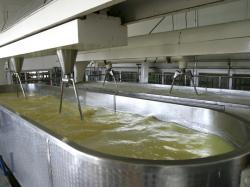The High Tech Of Small-Batch Cheese
November 24, 2014 | 2 min to read

In many cities these days, cheeses described as “small-batch” and “artisanal” dot the shelves of farmer’s markets the supermarkets alike. These descriptors probably conjure images of an aproned farm maid milking her cows by hand and then spending the afternoon turning her sloshing buckets into cheddar or mozzarella. The reality is that while artisanal cheesemaking certainly depends on the care and skill of a knowledgeable maker, the picture of an idyllic, technology-free farm isn’t quite right. Modern cheesemaking, even the artisanal kind, uses technology and a less quaint, but more safety-oriented approach to produce the high-quality wedges and rounds that will grace cheese plates around the country over the coming holiday season.
Take Donna Pacheco, the owner of Achadinha Cheese Company in Marin County, California, for example. Her farm—which has been in her husband’s family for more than 50 years and is now run by the two of them and their four children—sits atop one the area’s many hills, with verdant green pastures dotted with grazing animals surrounding the classic farmhouse where the family lives and the collection of barns at the end of a dirt driveway. Pacheco is also the quintessential farmer, wearing muck boots as she moves through her morning chores, a shaggy dog following close behind. Her cheesemaking and farming are closely connected, she says, with the pastureland, milking room, and aging room all within sight of each other. Yet while Pacheco is involved in every aspect of cheesemaking, she has mechanical help too.
A visit to the small cheesemaking house, built expressly for that task, feels more like entering the sterile, modern confines of a hospital room. While most small-batch food production needs to follow specific food safety laws, cheesemaking is particularly regulated because of the dairy industry’s high potential for spreading illness. Pasteurization standards were put into effect in 1933, when at least a quarter of food- and water-born ailments could be traced to contaminated milk, and modern facilities are built with these regulations in mind.
To read the rest of the story, please go to: The Atlantic
